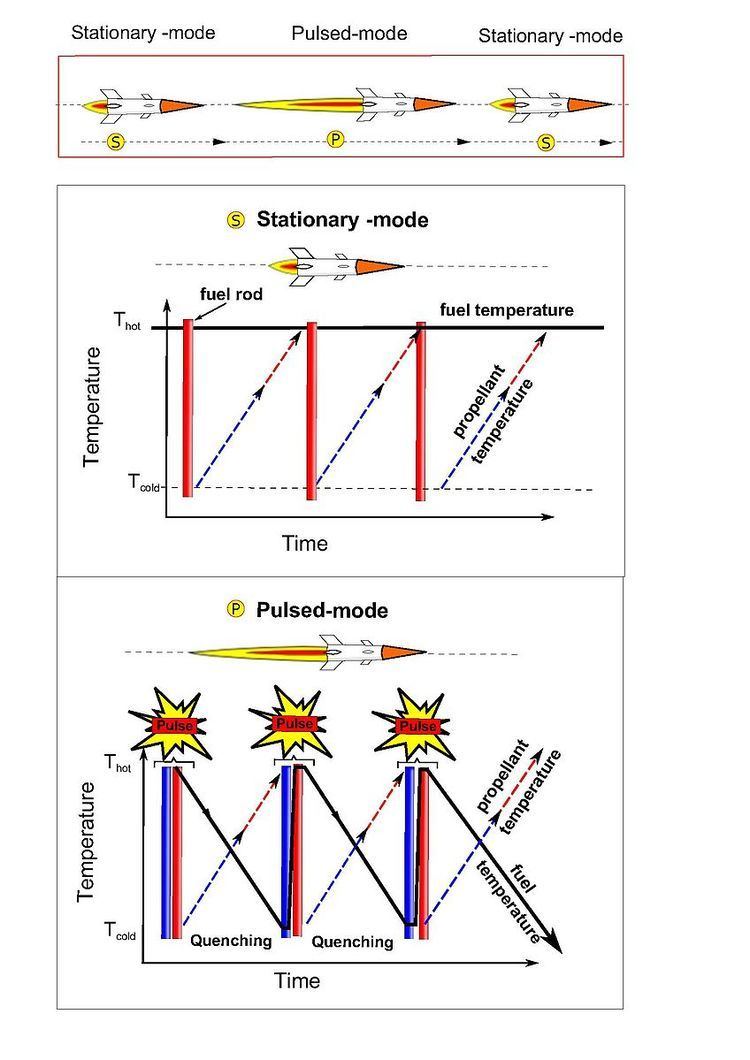 | ||
A pulsed nuclear thermal rocket is a type of nuclear thermal rocket (NTR) concept developed at the Polytechnic University of Catalonia, Spain and presented at the 2016 AIAA/SAE/ASEE Propulsion Conference for thrust and specific impulse (Isp) amplification in a conventional nuclear thermal rocket.
Contents
- Statement of the concept
- Direct thrust amplification
- Isp amplification
- Advantages of the design
- Other considerations
- References
The pulsed nuclear thermal rocket is a bimodal rocket able to work in a stationary ( at constant nominal power as in conventional NTR), and as well as a pulsed mode as a TRIGA-like reactor, making possible the production of high power and an intensive neutron flux in short time intervals. In contrast to nuclear reactors where velocities of the coolant are no larger than a few meter per second and thus, typical residence time is on seconds, however, in rockets chambers with subsonic velocities of the propellant around hundreds of meters per second, residence time are around
Statement of the concept
A rough calculation for the energy gain by using a pulsed thermal nuclear rocket in comparison with the conventional stationary mode, is as follows. The energy stored into the fuel after a pulsation, is the sensible heat stored because the fuel temperature increase. This energy may be written as
where:
On the other hand, the energy generated in the stationary mode, i.e., when the nuclear core operates at nominal constant power is given by
where:
Also, for the case of cylindrical geometries for the nuclear fuel we have
and the linear power given by
Where:
Therefore, the energy ratio between the pulsed mode and the stationary mode,
Where the term inside the bracket,
Typical average values of the parameters for common nuclear fuels as MOX fuel or uranium dioxide are: heat capacities, thermal conductivity and densities around
where
Quenching rates on
Direct thrust amplification
The most direct way to harness the amplified energy by pulsing the nuclear core is by increasing the thrust via increasing the propellant mass flow.
Increasing the thrust in the stationary mode -where power is fixed by thermodynamic constraints, is only possible by sacrificing exhaust velocity. In fact, the power is given by
where
where
Isp amplification
The attainment of high exhaust velocity or specific impulse (Isp) is the first concern. The most general expression for the Isp is given by
being
being
In a conventional stationary NTR, the energy
In summary, if the pulse generates
Where:
With values of
Advantages of the design
There are several advantages relative to conventional stationary NTR designs. Because the neutron energy is transported as kinetic energy from the fuel into the propellant, then a propellant hotter than the fuel is possible and therefore the
The other rocket concept which allows a propellant hotter than the fuel is the fission fragment rocket, however, in the pulsed rocket concept, the propellant is heated instantaneously as a burst rather than by continuous heating as in the fission fragment concept, then very high propellant temperatures are theoretically attainable immediately after the pulse, which is followed by a rapid radiative cooling. Therefore, by reducing the residence time of the propellant after the pulse will reduce the losses in propellant temperature.
Other considerations
For
As regard to the mechanism for pulsing the core, the pulsed mode can be produced using a different variety of configurations depending of the desired frequency of the pulsations. For instance, the use of standard control rods in a single or banked configuration with motor driving mechanism or the use of standard pneumatically operated pulsing mechanisms are suitable for generating up to 10 pulses per minute, for the production of pulses at rates up to 50 pulsations per second, the use of rotating wheels introducing alternately neutron poison and fuel or neutron poison and non-neutron poison can be considered. However, for pulsations ranking the thousands of pulses per second (kHz), optical choppers or modern wheels employing magnetic bearings allow to revolve at 10 kHz. If even fast pulsations are desired, then, it would be necessary the use of a new type of pulsing mechanism that does not involve mechanical motion, for example, lasers (based in the 3He polarization) as early proposed by Bowman, or proton and neutron beams. For the nuclear thermal rocket frequencies in the order of 1 kHz to 10 kHz are the choice.
